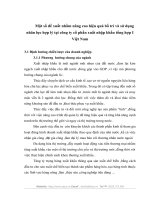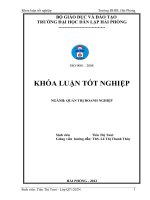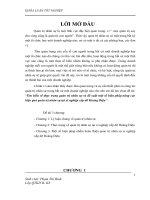Nâng cao hiệu quả điều trị và giảm tái nhập viện ở người bệnh suy tim mạn vai trò của đơn vị suy tim
Bạn đang xem bản rút gọn của tài liệu. Xem và tải ngay bản đầy đủ của tài liệu tại đây (4.02 MB, 33 trang )
Hội nghị Tim mạch Toàn quốc - Hà nội - 10/2016
Vietnam National Heart Association Congress of Cardiology
Nâng cao hiệu quả điều trị và giảm tái
nhập viện ở người bệnh suy tim mạn:
Vai trò của đơn vị suy tim
Improve treatment effectiveness and reduce
readmisseion of chronic heart failure:
Roles of Heart Failure Clinic
TS. NGUYỄN THỊ THU HOÀI
VIỆN TIM MẠCH QUỐC GIA VIỆT NAM
Epidemiology of Heart Failure in US
Heart Disease and Stroke Statistics - 2016 Update
Heart failure mentioned
on 1 of 9 death certificates
Circulation. 2015;132
Epidemiology of Heart Failure in US
Heart Disease and Stroke Statistics--2016 Update
Treatment costs
exceed $30 billion
Circulation. 2015;132
3500
Trends of absolute numbers of heart failure and CVD
patients at Vietnam National Heart Institute
3000
2500
1900
2000
1500
1914
1962
1766
1416
1000
500
0
1
2003
2
3
2005
2004
4
2006
5
2007
Heart Failure
Hypertension
Ischemic heart disease
Rheumatic heart disease
Congenital heart desease
Pericardial disease
Arrhythmia
Cardiomyopathies
Endocarditis
Cerebrovascular disease
PAD
DVT
Systolic versus Diastolic Heart Failure
HFREF versus HFPEF
Proposed Definitions
•
•
•
•
Systolic Heart Failure
Clinical signs and
symptoms – dyspnea,
edema, fatigue
CXR – pulmonary
congestion
Typical clinical response
to treatment
Reduced systolic function:
EF < 0.50
•
•
•
•
•
Diastolic Heart Failure
Clinical signs and symptoms
- dyspnea, edema, fatigue
CXR – pulmonary
congestion
Typical clinical response to
treatment
LV EF > 0.50
Diastolic dysfunction by cath
LVEDP
Circulation 2000;101:2118-2121
Evolving
Models
of
Heart
Failure
Evolving Models of Heart Failure
Genetic
Therapies to
Neurohormonal modulate
Hemodynamic
ACE inhibitors,
apoptosis,
Vasodilators or
beta blockers, and
Cardiorenal
fibrosis,
positive inotropes other agents to block remodeling,
Digitalis and
to relieve ventricular
neurohormonal
diuretic to
arrhythmic
wall stress
activation
perfuse kidneys
substrates
1940s
1940s
Pepper, Arch Intern Med 1999.
1960s
1960s
1970s
1970s
1990s–2000
1990s–2000
Future
Future
Circula( on
+
0
A
B
C1
C2
P<0.0001
D
Ammar et al: Circulation 115:1563, 2007
PREVENT ADVANCING HF
Circula( on
Hunt SA et al. Circulation 2009;119: e391-e479
©2014 MFMER | 3307694-13
•
•
•
Circ
Curr+Heart+Fail+Reports+
Drug Therapy
LMW
Heparin
Clopidogrel
Digoxin
CP943451-2
ICD: Gold Standard of Sudden Cardiac Death Prevention
Secondary Prevention: AVID
Primary Prevention: SCDHeFT
1.0
0.4
HR (95% CI)
1.06 (0.86-1.30)
0.77 (0.62-0.96)
Amiodarone vs placebo
ICD therapy vs placebo
P
0.53
0.007
Defibrillator group
0.3
0.6
Mortality rate
Proportion surviving
0.8
Antiarrhythmic-drug group
0.4
Amiodarone
0.2
ICD therapy
0.1
0.2
Placebo
0.0
0.0
0
1
2
Follow-up (years)
3
0
12
24
36
Follow-up (months)
N Engl J Med 1997;337:1576; N Engl J Med 2002;346:877
48
60
Ventricular Resynchronization
Sinus node
Intraventricular Activation
• Organized ventricular activation
sequence
AV
node
• Coordinated septal and freewall
contraction
• Improved pumping efficiency
Conduction
block
Stimulation therapy
Kass D. New dimensions in device-based therapy for heart failure–mechanisms of stimulation for heart failure. Heart Failure Society of America 1999.
Therapies for End-Stage Heart
Failure
• Ventricular assist device
• Bridge to transplant
• Destination therapy
• Heart transplant
Hospital Visits for Congestive Heart Failure
Initial Episode
21%
Repeat Visit 79%
Rates of readmission
• 2% within 2 days
• 25% within 1 month
• 50% within 6 months
Causes of Hospital Readmission for
Congestive Heart Failure
Diet Noncompliance
24%
Rx Noncompliance
24%
16%
Inappropriate Rx
19%
Failure to Seek
Care
Vinson J Am Geriatr Soc 1990;38:1290-5
17%
Other
IMPROVE TREATMENT
EFFECTIVENESS OF HEART FAILURE
1. Prevent progression to next stage.
2. Reduce admission
3. Prevent re-admission
4. Reduce mortality
Cooperative Heart Failure Care Heart Failure Clinic
• How we lower re-hospitalization rate
• How we increase the rate of using guideline-based
medications.
• How we educate HF patients, encourage their self-care,
activate their motivation.
• How we start HF rehab and make it a safe environment.
• How we use IT
• How we orchestrate the team
Heart Failure Clinic
Delivers individualized care
•
•
•
•
•
•
•
•
•
•
•
Physician
Nurse
Pharmacist
Case Manager
Nursing Director
Physical Therapist and/or Occupational Therapist
Care Transitions team member
Social Worker
Dietitian
Discharge Nurse
Respiratory Therapis
Case management
1. To educate patient with knowledge of heart failure
2. To improve self-care at home
3. To decrease re-admission rate
Re-admision, why?
1. Poor diet control, followed by fluid overload
2. Did not keep targeted weight
3. Poor medication compliance
4. Did not note the change of their symptoms and signs.
5. Miss clinical follow-up
There are many reasons…
-> Self-care is very important!
After discharge, patients “know”
1. Low salt diet
2. Fluid restriction
BUT
- Do we accurately intergrate this “know how” in to their
REAL LIFE PRACTICE?
- After discharge, patients do not understand how to
adequately take care of themselves.
SET UP
Education program “one to one” interaction
Goal
Rise awareness of heart failure
Strategy to activate motivation
1. Demonstrate a future for them
2. Help patients understand their disease severity
3. Turn the hospitalization time into a self-care training
course.
Educating self-care to HF patients
1. Measure BP, HR, record I/O
2. Measure body weight and maintain safe body weight
3. Low salt diet, limit water intake
4. Know when to report a worsening of disease
5. Differentiate between HF medication types, know
when to use diuretics.
6. Maintain prescribed exercise and routin clinic visits.









